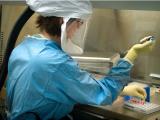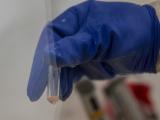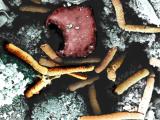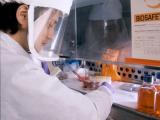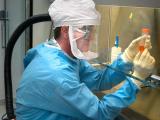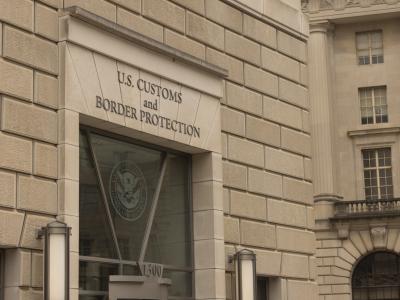Aug 20, 2008 (CIDRAP News) – The FBI, seeking to counter scientific skepticism on its investigation into the 2001 anthrax attacks, insisted this week that the anthrax powder could have been made by one person and contained no "intentional additives" to make it more dispersible.
At an Aug 18 news conference, the agency also acknowledged a specific error in the investigation and promised to release detailed information on the probe in peer-reviewed scientific journals.
At the same time, officials conceded that they probably will never be able to dispel all doubts about the case against Bruce E. Ivins, the anthrax researcher who died in an apparent suicide as the FBI was about to announce charges against him.
"I don't think we're ever going to put the suspicions to bed," said Vahid Majidi, assistant director of the FBI's Weapons of Mass Destruction Directorate, as quoted in press accounts. "There's always going to be a spore on a grassy knoll."
The mailing of anthrax-laced letters to two US senators and several media offices in the fall of 2001, shortly after the Sep 11 terrorist attacks, killed five people and sickened 17 others. The FBI outlined its case against Ivins on Aug 6 of this year, just 9 days after he died of an overdose of painkillers. Ivins had worked for years at the US Army Research Institute of Infectious Diseases (USAMRIID) at Fort Detrick in Maryland.
The FBI has said its experts and other scientists helping with the investigation developed a new DNA fingerprinting technique that enabled them to match the anthrax used in the attacks with a batch of anthrax that was in Ivins' custody, known as RMR-1029. The agency has not released a detailed scientific report on the DNA evidence. Aside from that claim, the case against Ivins is mostly circumstantial, and a number of scientists have voiced doubts about it.
Early in the investigation, the FBI indicated that the mailed anthrax was a weaponized product, treated or processed to make it spread more easily through the air and penetrate deep into the lungs. It was reported that the powder contained silicon and that Army experts had been unable to replicate the material. The implication was that one person working alone would not have been able to produce the powder.
But in a statement presented at this week's news conference, Majidi said, "There were no intentional additives combined with the Bacillus anthracis spores to make them any more dispersible."
According to a New York Times report on the press conference, FBI officials said investigators determined that the making of the powder was a relatively simple process of cleaning and drying anthrax spores. "FBI scientists easily reproduced it with gear that Ivins regularly used," the article stated.
However, silicon was found in the mailed anthrax (as reported previously), and FBI officials conceded that the duplicate powder they made did not match the letter anthrax in that respect, according to reports by the Times and the Washington Post. FBI scientists said they concluded that the high level of silicon occurred naturally in the anthrax used in the attacks, the Times reported.
The investigative error acknowledged by the FBI this week had to do with the handling of the first anthrax sample they obtained from Ivins. According to the Times, FBI officials revealed that they first obtained a sample of a unique strain of anthrax from him in 2002 and that it could have led them to the strain used in the attacks. However, the agency "destroyed the sample because Dr. Ivins did not follow protocol in the way it was submitted, making it more difficult to use in court," the story said.
But it turned out that an extra copy of Ivins' sample was kept by Paul Keim, a Northern Arizona University biologist who helped with the investigation, and he provided it to the FBI when the agency asked for it in 2006, according to the Post.
The FBI then realized the sample was the same strain used in the attacks, which helped confirm other evidence implicating Ivins, the Times reported. "Looking at it in hindsight, we would do things differently today," the newspaper quoted Majidi as saying.
In his Aug 18 written statement, Majidi listed several sophisticated techniques that were used in analyzing the mailed anthrax: scanning and transmission electron microscopy, energy dispersive x-ray analysis, carbon dating by accelerator mass spectrometry, and inductively coupled plasma-optical emission and mass spectrometry.
"Through a comprehensive analytical approach, the investigators were provided with validated scientific data which linked the material used in the 2001 anthrax attacks to material from USAMRIID identified as RMR-1029," Majidi said.
"It is important to emphasize that the science used in this case is highly validated and well accepted throughout the scientific community. The novelty is in the application of these techniques for forensic microbiology."
Further, Majidi said the information released this week was "the first step toward broader dissemination of the scientific information surrounding this case. Additional information will be available through peer-reviewed publications and I ask you to respect the integrity of this process."
In other information given at the news conference, officials said the Institute for Genomic Research had sequenced the full DNA of several anthrax strains by 2002, suggesting it might be possible to link the letter anthrax to its source by identifying specific mutations, according to the Times.
It took another year to identify the four distinctive mutations the FBI has reported, the story said. Meanwhile, the FBI collected more than 1,000 samples of the Ames strain of anthrax, the strain used in the attacks, and started using its genetic test on them.
The FBI found that 8 of the 1,000 samples carried the four mutations, as reported previously. According to the Times, 100 scientists had access to or were associated with those eight samples, and all of them were investigated. The body of evidence pointed to Ivins, the story said.
As expected, the FBI's new revelations did not eliminate skepticism about the case. Dr. Richard Spertzel, a retired microbiologist who led the United Nations' biological weapons inspections in Iraq, called the FBI's new presentation "a pretty tenuous argument," according to the Times. He specifically questioned the agency's claim that the letter anthrax was not "military grade."
In addition, Dr. C.J. Peters, a virologist at the University of Texas Medical Branch in Galveston, said it is puzzling that the FBI has not reported finding traces of the letter anthrax in places where Ivins lived and worked, given how widely the spores were dispersed in settings such as the Washington, DC, post office that processed the letters mailed to senators.
"I would contend that anywhere he made the powder or manipulated the powder was almost certainly contaminated," Peters told CIDRAP news by e-mail. "Think about the pos[itive] nasal swabs in the Hart office building or environmental swabs in the post office. Look at the spore counts on the protective gear when the Leahy letter was detected."
See also:
Aug 15 CIDRAP News story
http://www.cidrap.umn.edu/cidrap/content/bt/anthrax/news/aug1508anthrax.html

